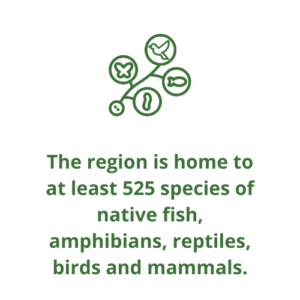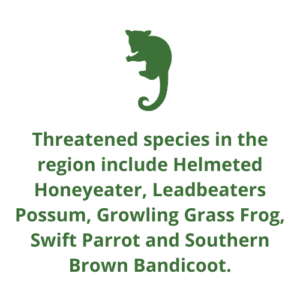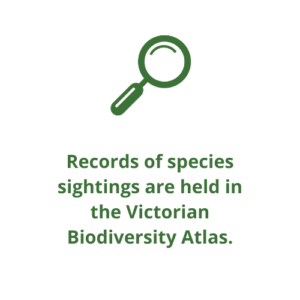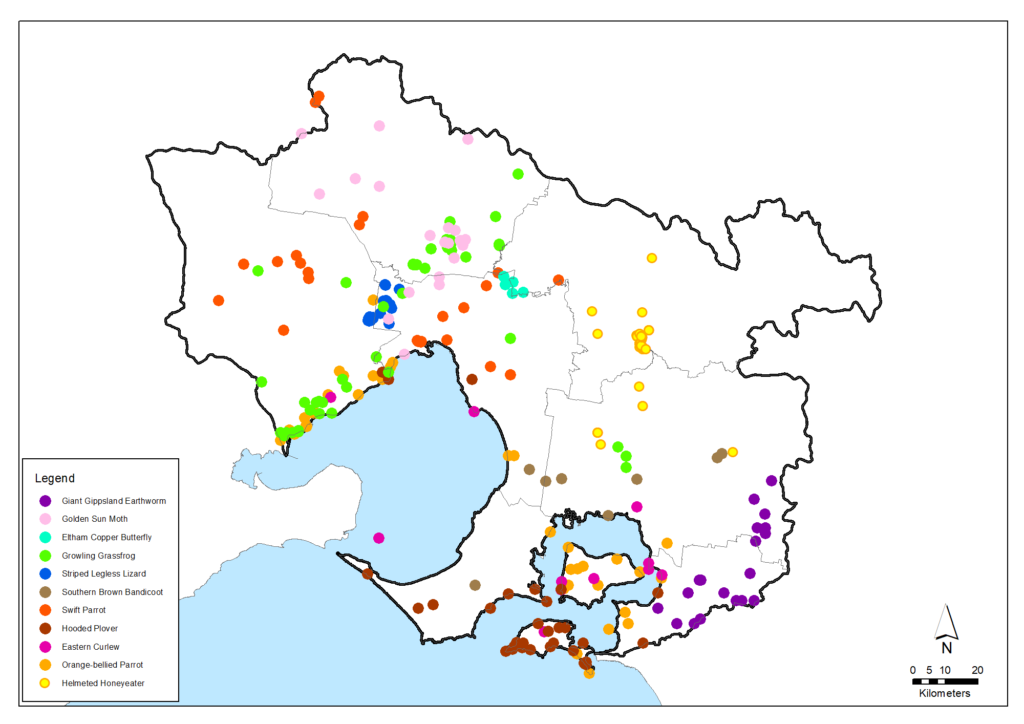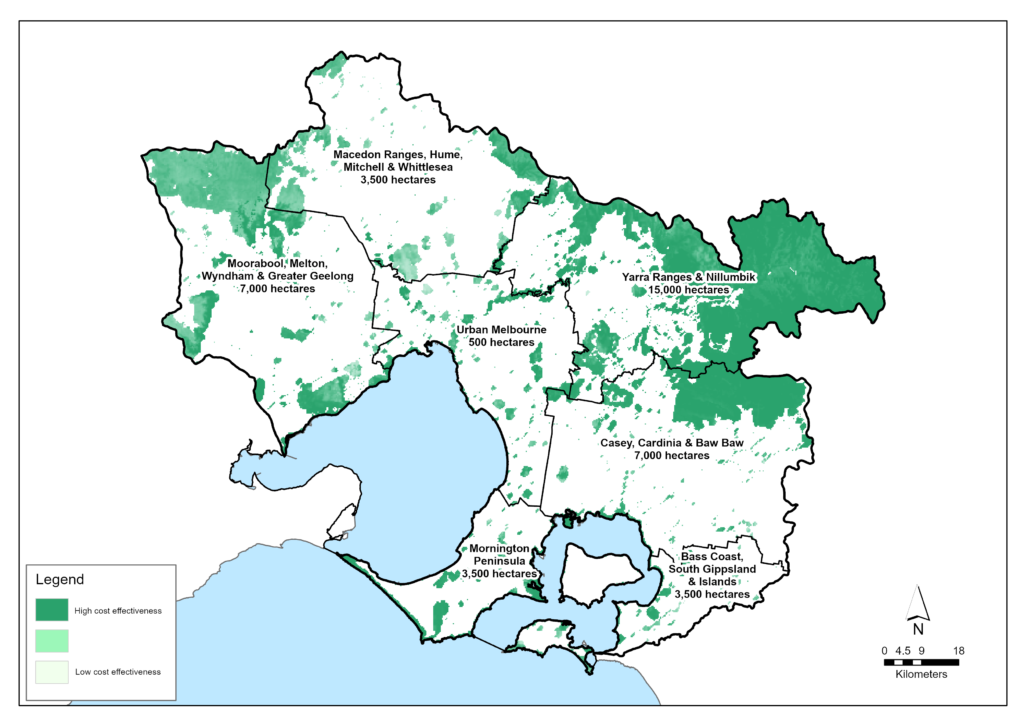All creatures great and small
The Port Phillip and Western Port region is home to national icons like koalas, kangaroos and platypus as well as unique local species like the Helmeted Honeyeater and Leadbeater’s Possum.
Native animals play a vital role in keeping our ecosystems healthy and diverse and their habitats are connected in many ways. Every animal species supports the abundance or health of others and therefore, any loss of species threatens the health and resilience of ecosystems and their capacity to be productive and beneficial.
Native animals are important for various reasons:
- Native animals are an indicator of healthy ecosystems, waterways and habitats – for example frogs in wetlands
- Native animals play important roles in ecosystems by keeping some animals from becoming too numerous (predators), managing vegetation growth (weeds) or providing food, and recycling organic matter (decomposers)
- The variety of native animals and the ecosystems in which they live contribute to the quality of life we have
- Each year, thousands of tourists visit the region to see our native plants and animals.
The region’s native animals have suffered since European settlement, with close to 100 species becoming extinct and many other’s now considered endangered.
Policy and planning
Legislation specifically focused on biodiversity protection and management includes the Flora and Fauna Guarantee Act 1988 (Vic). It is the key piece of Victorian legislation for the conservation of threatened species and communities and for the management of potentially threatening processes.
Nationally threatened species are afforded further protection under the Australian Government’s Environment Protection and Biodiversity Conservation Act 1999 (Aus). The national Threatened Species Strategy 2021-2031 outlines an action-based approach to protecting and recovering Australia’s threatened plants, animals and ecological communities.
The Victorian Government has also put in place the Protecting Victoria’s Environment – Biodiversity 2037 plan outlining the long-term vision for Victoria’s biodiversity supported by two overarching goals of Victorians valuing nature and Victoria’s natural environment being healthy.
In May 2020, the Minister for Energy, Environment and Climate Change announced a comprehensive review of the Wildlife Act 1977 (Vic). The Act contains strict guidelines and regulations about the treatment and handling of wildlife in Victoria and specifies various do’s and don’ts with regards to rescue, removal and rehousing of animals. The guidelines have been put in place to ensure minimal harm to both animals and environments within Victoria.
Parks Victoria manages by far the largest and most intact of the region’s native habitats and ecosystems. Parks Victoria’s estate of National, State and Regional Parks and Nature Conservation Reserves comprises 172,600 hectares of land across the Port Phillip & Western Port region. Parks Victoria is using the internationally recognised Conservation Action Planning method to make strategies that will help it improve the health of ecosystems in the region’s National, State and Regional Parks.
Traditional Owners are the voice of their Country
For all policy and planning, there is a need for recognition and inclusion of Traditional Owner knowledge and aspirations (see target 13.1). The water and lands are increasingly being recognised as ‘living and integrated natural entities‘ and the Traditional Owners should be recognised as the ‘voice of these living entities’. Country Plans will describe the vision and priorities of the Traditional Owners for Country in line with their roles as Registered Aboriginal Parties, and will provide a strong basis for all planning to recognise and include the voice of these Traditional Owners.This region’s native animal species now
Diversity of native animal species
Over the past 200 years, this region has been home to an estimated 627 species of native fish, amphibians, reptiles, birds and mammals as well as many more smaller animal species such as insects.
However, the diversity of native animal species has declined in this region in response to habitat loss, pest predation and other factors, as indicated in the table below from an analysis of animal sighting data that calculated the probability that each species of native fish, amphibians, reptiles, birds and mammals was persisting in the Local Areas of this region at the end of 2016.
The analysis drew on over 3 million records from between 1839 and the end of 2016 (from the Victorian Biodiversity Atlas and other databases). The analysis noted that there has been a substantial increase in species records over the last 15 years due to the contributions of government agencies that manage species databases and the public through citizen science programs.
The analysis indicated that each of the seven terrestrial Local Areas has an overall persistence rate of between 71-78% of the total number of species recorded as occurring there. In general, birds and amphibians seem to have fared the best in retaining species whereas fish species generally show the greatest declines.
There are limitations to the methods used in the analysis, including that it doesn’t assess the health or range of species populations. For example, a species such as the Helmeted Honeyeater can have a small population, a confined range and be listed as a threatened species but have a high persistence rating in that area because sightings are regularly recorded. Conversely, some species may be relatively common in an area but if the databases do not contain recent records of sightings then the probability of persistence can be low.
Number and proportion of species likely to be persisting in each Local Area (at 2016)
| Bass Coast, South Gippsland & Islands | Casey, Cardinia & Baw Baw | Mornington Peninsula | Yarra Ranges & Nillumbik | Urban Melbourne | Macedon Ranges, Hume, Mitchell & Whittlesea | Moorabool, Melton, Wyndham & Greater Geelong | |
| Birds | 217/274 (79%) | 236/291 (81%) | 225/295 (76%) | 228/277 (82%) | 303/374 (81%) | 235/279 (84%) | 284/337 (84%) |
| Mammals | 19/34 (56%) | 29/41 (71%) | 17/33 (52%) | 37/46 (80%) | 29/49 (59%) | 32/43 (74%) | 33/41 (80%) |
| Amphibians | 6/10 (60%) | 10/16 (63%) | 11/13 (85%) | 11/14 (79%) | 15/20 (75%) | 13/16 (81%) | 10/13 (77%) |
| Reptiles | 11/22 (50%) | 19/30 (63%) | 16/26 (62%) | 22/37 (59%) | 33/39 (82%) | 21/34 (62%) | 18/34 (53%) |
| Fish | 2/15 (13%) | 8/26 (31%) | 5/18 (28%) | 13/26 (50%) | 18/32 (56%) | 5/20 (25%) | 4/20 (20%) |
| Total | 255/355 (72%) | 302/404 (75%) | 274/385 (71%) | 311/400 (78%) | 397/514 (77%) | 306/392 (78%) | 349/445 (78%) |
Threatened species
Threatened species are considered to be priorities for protection and recovery work. In many circumstances, work to protect and enhance threatened species can also benefit other native flora and fauna species and communities.
A review of Victoria’s threatened species list was completed by the former Department of Environment, Land, Water and Planning (now Department of Energy, Environment and Climate Action) in 2021. An estimated 159 species of native animals known to occur in this region since 1980 are listed as threatened. Some of those are identified in the table below. More detailed lists of threatened species are available at the Data tables page of this strategy and at the Victorian threatened species list.
The map shows some of the recent recorded sightings of 11 threatened species, illustrating that, even when considering just this small number of species, virtually all areas of the region are important for threatened species.
Numerous ongoing programs and initiatives are in place seeking to protect and enhance the populations and resilience of various threatened species. The Department of Energy, Environment and Climate Action, Parks Victoria, Zoos Victoria, community groups (such as the Friends of the Helmeted Honeyeater and the Friends of the Leadbeaters Possum) and others make significant contributions to these efforts. The Mt Rothwell Biodiversity Centre is also making a significant contribution to reintroductions of threatened species including Eastern Barred Bandicoot, Eastern Quoll, Eastern Bettong and Southern Brush Tail Rock Wallabies.
| Species | Bass Coast, South Gippsland & islands | Casey, Cardinia & Baw Baw | Mornington Peninsula | Yarra Ranges & Nillumbik | Urban Melbourne | Macedon Ranges, Hume, Mitchell & Whittlesea | Melton, Moorabool, Wyndham & Greater Geelong | Port Phillip Bay | Western Port |
|---|---|---|---|---|---|---|---|---|---|
| Birds | |||||||||
| Australasian Bittern | X | X | X | X | X | X | X | X | |
| Curlew Sandpiper | X | X | X | X | X | X | X | ||
| Eastern Curlew | X | X | X | X | X | X | X | ||
| Fairy Tern | X | X | X | X | X | X | |||
| Helmeted Honeyeater | X | X | |||||||
| Hooded Plover | X | X | X | X | X | X | |||
| Orange Bellied Parrot | X | X | X | ||||||
| Plains-wanderer | X | ||||||||
| Red Knot | X | X | X | X | X | X | |||
| Sooty Owl | X | X | X | X | |||||
| Swift Parrot | X | X | X | X | X | X | |||
| Mammals | |||||||||
| Burrunan Dolphin | X | X | |||||||
| Eastern Barred Bandicoot | X | X | |||||||
| Eastern Bent Winged Bat | X | X | X | X | |||||
| Leadbeater's Possum | X | X | |||||||
| Platypus | X | X | X | X | X | X | X | ||
| Smoky Mouse | X | ||||||||
| Spot-tailed Quoll | X | X | |||||||
| Southern Brown Bandicoot | X | X | X | X | |||||
| Southern Humpback Whale | X | X | |||||||
| Southern Right Whale | X | X | |||||||
| Reptiles | |||||||||
| Striped Legless Lizard | X | X | |||||||
| Swamp Skink | X | X | X | X | |||||
| Lace Monitor | X | X | X | X | X | X | X | ||
| Tussock Skink | X | X | X | X | |||||
| Amphibians | |||||||||
| Growling Grass Frog | X | X | X | X | X | X | X | ||
| Brown Toadlet | X | X | X | X | |||||
| Southern Toadlet | X | X | X | X | X | X | |||
| Fish | |||||||||
| Australian Grayling | X | X | X | ||||||
| Little Galaxias | X | X | X | ||||||
| Macquarie Perch | X | X | |||||||
| Invertebrates | |||||||||
| Eltham Copper Butterfly | X | X | |||||||
| Giant Gippsland Earthworm | X | X | |||||||
| Golden Sun Moth | X | X | X | X |
Key challenges
Habitat loss and decline
Damage to habitat extents, quality and connectivity are critical pressures to native animal diversities and populations across the region. Nearly 24,000 hectares of native vegetation are estimated to have been cleared from the region over the last 30 years. Habitat losses have been most severe in native grasslands (generally in the west of the region), scattered trees and wetlands. Most of the region’s remaining intact woodlands and tall forest are protected in parks and reserves. Clearing for new residential and infrastructure developments are obvious habitat destructions but loss and damage is also progressing in small-scale tree and garden demolitions on hundreds of suburban house sites and rural properties every year.
Clearing regulations and permits are designed to achieve no-net-loss but practice is problematic:
- Tree retention and offset conditions on planning permits are difficult and expensive to enforce.
- Trees retained or replaced during construction may be incrementally cut down by subsequent owners.
- The financial penalties for illegal clearing are viewed by some landholder/developers as a ‘green-tape’ cost of getting things done.
- Approvals for major developments are generally granted if no state or nationally listed species or habitats are present on the site. Habitats and wildlife populations of common species, of local or regional significance or a site’s possible future values after rehabilitation are not assured protection by the planning system. This is a perverse effect of national and State laws to protect threatened species.
The use of the Victorian Biodiversity Atlas to locate valued plants and animals and frame conservation strategy is also proving to be limited. Much of its data is collected from sites associated with development applications but relatively few records are sourced from proactive wildlife and vegetation surveys. For example, the Atlas shows no sightings of the endangered Tussock Skink in the Urban Melbourne area since 2000 while recent Council surveys recorded precious populations of Tussock Skinks in public reserves and private land.
Urbanisation and population pressures
Urbanisation will continue to put pressure on native animal populations across the region and is expected to expand for decades to come, particularly in the new growth corridors. Development may often be on land cleared long ago and will create minimal habitat loss, but the off-site effects of development are of concern:
- Altered stream flows and water pollution from increasing urban stormwater run-off and more intensive road development and other disturbances on rural land.
- Waterways habitats damaged by flood protection works and sediment inputs.
- Barriers to animal movement created by roads and infrastructure.
- Continuing habitat damage from recreation, vandalism, informal vehicle tracks and rubbish.
- Continued incremental native vegetation clearing for buildings, fences, access, views etc.
The coasts and beaches of Port Phillip and Western Port hold some of Victoria’s most valuable shorebirds and seabird habitats. Careless boating, fishing and walking and associated intrusions by dogs and horses can cause significant disturbance and adverse impacts on coastal bird species, their breeding and migration success. Education and enforcement to protect vulnerable species during their breeding seasons are important conservation actions.
Climate change
While we can be certain that climate change will have significant and widespread impacts on biodiversity and natural ecosystems over time, the exact nature and scale of changes, and the degree to which individual species, populations and ecological processes can adapt, is still uncertain.
Many species have evolved over thousands of years and will not have the ability to adapt to a rapidly changing climate as easily as others. As a result, changes to the distribution of species is expected to occur. More intense rainfall and flash-flooding will also have potentially devastating impacts on already small, localised populations.
Climate change will exacerbate environmental pressures such as drought, wildfire, weeds and pest animals on natural habitats and biodiversity. Climate change is likely to be making obsolete and perilous the trade-offs between development and conservation used in previous ‘balanced decision-making’.
Fire
Australian plant and animal communities rely on ‘regimes’ of fire intensity, frequency, season, extent and type to regenerate and maintain health and diversity. Fire regimes create food, shelter and breeding sites for native animals.
A drier future climate will create the risk of more frequent and severe wildfire. The Victorian Climate Change Adaptation Program predicts that the number of ‘extreme’ fire danger days is expected to increase in the Port Phillip and Western Port Region by between 12 per cent and 38 per cent by 2020 and by between 20 per cent and 135 per cent by 2050.
Predators and competition
Invasive plants and animals are major threats to native animals. Of particular concern are:
- Predation and disturbance by domestic animals, particularly cats.
- Competition from native and exotic predators and scavengers that have benefitted from modern landscape changes. Foxes, feral cats and dogs are a particular problem
- Weed invasions that create structural decline in native vegetation.
These pressures are now well-established. Ongoing control is critical but expensive and needs to be carefully targeted to maximise its benefits.
Vision and targets for the future
Vision
The vision and one of the goals from the Protecting Victoria’s Environment – Biodiversity 2037 plan are:
Victoria’s biodiversity is healthy, valued and actively cared for. Victoria’s natural environment is healthy with functioning plant and animal populations, improved habitats and resilient ecosystems, even under climate change.
Regional Catchment Strategy targets
Achievement of the following targets for this region will contribute to realising the statewide vision.
Target 6.1 Diversity of native animals
The following target recognises the importance of the diversity of species for healthy and resilient ecosystems and will contribute to the achievement of the state-wide vision and goals.
Progress toward this target will be monitored through an occasional re-assessment of the ‘probability of persistence’ of species across the region that draws on records of native animal sightings. The re-assessments may be appropriate perhaps each 5 to 10 years.
Target 6.2 Threatened animals
Threatened species are considered to be priorities for protection and recovery work, with the following target seeking to retain all species and ensuring there are viable and healthy populations for the long term. In many circumstances, work to protect and enhance the health and resilience of threatened species’ populations can also benefit other native animal species and the local habitat.
Progress toward this target will be monitored using information developed and published by the Department of Energy, Environment and Climate Action.
Targets to extend and improve native habitat are also important for the future health and sustainability of native animal species. These are included in the Native vegetation section of this Regional Catchment Strategy.
Target 6.3 – Pest predator control
Another important target is the control of pest predators including foxes and cats. Of the statewide target of 1.5 million hectares of sustained pest predator control in priority locations from 2017 to 2037, this region’s contribution is proposed to be at least 40,000 hectares. The aspirational aim for this region is to achieve this level of control immediately and maintain it through to 2037 and then to 2050.
A particular aim for the region is to achieve eradication of feral cats on French Island. Given that the island is already fox-free, this will achieve a safe-haven for wildlife on this island that is home for numerous species that are threatened and/or of international significance. This would complement the recent achievement of Phillip Island becoming fox-free.
While pest predator control will be valuable all across the region, strategic priorities have been identified through the Victorian Government’s Strategic Management Prospects and Biodiversity Response Planning processes coordinated by the Department of Energy, Environment and Climate Action. The maps below summarise priorities for fox and feral cat control with further detail available at the NatureKit website.
The aspirational regional target of 40,000 hectares could be achieved with contributions across the region such as those outlined in the map below. These are nominal targets for each Local Area.
Progress toward this target will be monitored using data collated by the Department of Energy, Environment and Climate Action. This will be supplemented by regularly seeking information from key natural resource management organisations in the region such as councils, water corporations, Parks Victoria, relevant government and Landcare networks/groups about the amount and location of pest predator control they have undertaken or commissioned.
Partner organisations
The following organisations formally support the pursuit of the visions and targets for native animals. They have agreed to provide leadership and support to help achieve optimum results with their available resources, in ways such as:
- Fostering partnerships and sharing knowledge, experiences and information with other organisations and the community
- Seeking and securing resources for the area and undertaking work that will contribute to achieving the visions and targets
- Assisting with monitoring and reporting on the condition of the area.
Victorian Government
- Department of Energy, Environment and Climate Action (DEECA)
- Melbourne Water
- Parks Victoria
- Phillip Island Nature Parks
- Victorian Environmental Water Holder
- Trust for Nature
- Victorian Planning Authority
- Environment Protection Authority Victoria (EPA)
- Sustainability Victoria
- Westernport Water
- Zoos Victoria
Local Government
- Hume City Council
- Macedon Ranges Shire Council
- City of Greater Geelong
- Monash City Council
- Bayside City Council
- City of Melbourne
- Glen Eira City Council
- Kingston City Council
- City of Stonnington
- Knox City Council
- Maroondah City Council
- City of Casey
- Cardinia Shire Council
- Baw Baw Shire Council
- Bass Coast Shire Council
- South East Councils Climate Change Alliance
- City of Whittlesea
- Wyndham City
- Moorabool Shire Council
- Hobsons Bay City Council
- Brimbank City Council
- Moonee Valley City Council
- City of Greater Dandenong
- Whitehorse City Council
- South Gippsland Shire Council
- Eastern Region Pest Animal Network
- Western Alliance for Greenhouse Action
- Northern Alliance for Greenhouse Action
- Eastern Alliance for Greenhouse Action
Traditional Owners
- Wadawurrung Traditional Owners Aboriginal Corporation
- Bunurong Land Council Aboriginal Corporation
Non Government
- The Nature Conservancy
- Conservation Volunteers Australia
- Mt Rothwell Biodiversity Centre / Odonata
- Gardens for Wildlife Victoria
- Marine Mammal Foundation
- The People and Parks Foundation
- Field Naturalists Club of Victoria
- Victorian National Parks Association
- Dolphin Research Institute
- Native Fish Australia (Vic)
- OzFish Unlimited
- Birdlife Australia
- Victoria Walks
- Western Port Seagrass Partnership
- Habitat Restoration Fund
Community
- Port Phillip EcoCentre
- Werribee River Association
- Friends of Lower Kororoit Creek Inc
- NatureWest
- Jacksons Creek EcoNetwork
- Greening of Riddell
- Friends of Emu Bottom Wetlands Reserve
- Friends of Daly Nature Reserve
- Deep Creek Landcare Group
- Riddells Creek Landcare Group
- Newham and District Landcare Group
- Upper Deep Creek Landcare Network
- Merri Creek Management Committee
- Darebin Creek Management Committee
- Little River Community Landcare Inc
- Federation for Environment and Horticulture in the Macedon Ranges
- Yarra Ranges Landcare Network
- Middle Yarra Landcare Network
- Northern Yarra Landcare Network
- Nillumbik Landcare Network
- Friends of Dandenong Valley Parklands
- Nangana Landcare Network
- Johns Hill Landcare Group
- Gippsland Threatened Species Action Group
- Mornington Peninsula Landcare Network
- Main Creek Catchment Landcare Group
- Merricks Coolart Catchment Landcare Group
- Red Hill South Landcare Group
- Sheepwash Creek Catchment Landcare Group
- Manton and Stony Creeks Landcare Group
- Cardinia Environment Coalition
- Bass Coast Landcare Network
- Bass Valley Landcare Group
- French Island Landcare Group
- South Gippsland Landcare Network
- Loch-Nyora Landcare Group
- Mt. Lyall Landcare Group
- Poowong & District Landcare Group
- Triholm Landcare Group
- Friends of Dandenong Valley Parklands
- Kooyongkoot Alliance
- Friends of Olinda Creek
- Mornington Peninsula Koala Conservation
- Phillip Island Landcare Group
- Western Port Catchment Landcare Network
- Westernport Swamp Landcare Group
Add your organisation as a supporter and partner
If your organisation supports these directions and targets for native animals and wishes to be listed as a partner organisation, you can request to be listed as a partner organisation. Adding your organisation to this list will:
- Enable your organisation to list one or more priority projects in the Prospectus which will describe how your priority project will pursue the targets of this Regional Catchment Strategy and potentially make your organisation’s project more attractive to investors by using the strategy to highlight its relevance and value
- Demonstrate your commitment to a healthy and sustainable environment
- Demonstrate the level of community engagement and support for this work.
Priority projects to move forward
Priority projects
There are significant ongoing programs and initiatives undertaken by many organisations in this region that are vital for protecting and enhancing populations of native animals. For example, there are collaborative programs under way including the Ramsar Partnership Program, Planning Deer Control in Peri-urban Areas, Good Neighbour Program, French Island Feral Cat Eradication Project, Grey Headed Flying Fox program, Faunal Emblems and the Yellingbo Landscape Conservation Area.
In addition, there are numerous project proposals that, if funded and implemented, can contribute to achieving the Regional Catchment Strategy’s visions and targets for native animals. Projects include:
- Permanently Protecting Melbourne Habitat led by Trust for Nature
- Faunal Emblems Program led by Parks Victoria
- A Swift Response – proposed by Melbourne Water to assist Swift Parrot
- Yering Gorge to Yarra Junction Integrated Catchment Management Project proposed by Melbourne Water to assist Helmeted Honeyeater
- Securing the future for lowland Leadbeater’s Possum proposed by Melbourne Water
- Eltham Copper Butterfly Habitat Restoration proposed by Melbourne Water
- Biolinks for the Brush-tailed Phascogale – proposed by Melbourne Water as part of the Grow West program
- Bandicoots in our Backyards proposed by Melbourne Water
- Beyond Yellingbo led by the Nangana Landcare Network
- Bunjil and Bandicoots on the Flight Path led by the Chain of Ponds Collaboration
- Upper Yarra Habitat led by Yarra Valley Water
- Macquarie perch in the Yarra River proposed by Native Fish Australia (Victoria)
- A lifeline for Fairy Terns led by Birdlife Australia
- Building Site Action Plans for Migratory Seabirds led by Birdlife Australia
- Community Conservation of the Hooded Plover led by Birdlife Australia
- Project Burrunan led by the Marine Mammal Foundation
- Devilbend Threatened Species Protection led by the Mornington Peninsula Landcare Network
- Mornington Peninsula koala biolink led by Mornington Peninsula Koala Conservation
- North Western Port Nature Conservation Reserve Introduced Predator Management proposed by Parks Victoria
- Quail Island and Chinaman Island Introduced Predator Management proposed by Parks Victoria
- Reef Island and Bass River Mouth Nature Conservation Reserve Introduced Predator Management proposed by Parks Victoria
- French Island Introduced Predator Management proposed by Parks Victoria
- Mornington Peninsula and Point Nepean National Parks Introduced Predator Management proposed by Parks Victoria.
A list of project proposals across the region and their key details can be viewed on the Prospectus section of this website.
Propose a new priority project
As part of the ongoing development and refinement of this Regional Catchment Strategy, additional priority projects may be considered for inclusion in the Prospectus.
If your organisation supports the directions and targets for native animals, and has a project proposal it would like highlighted and supported in this Regional Catchment Strategy, please submit a Prospectus Project Proposal.

